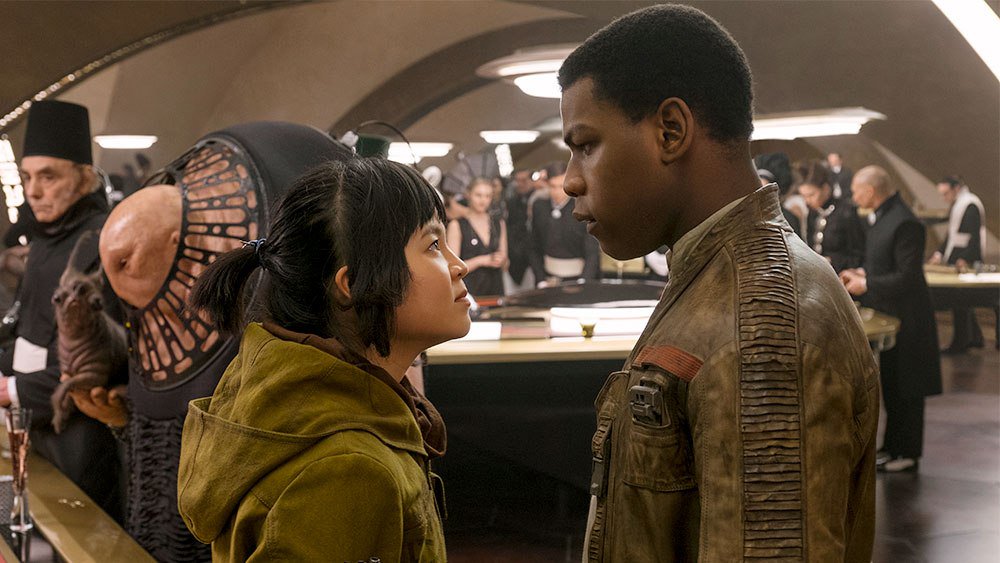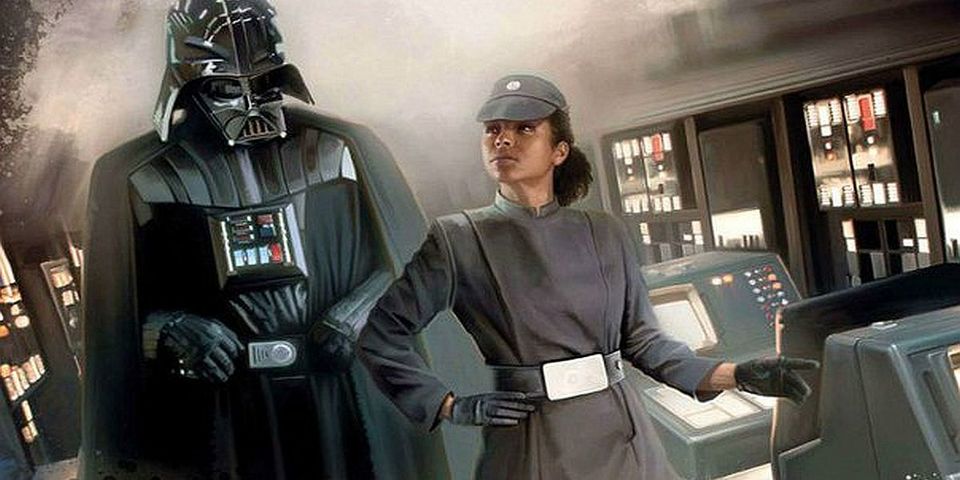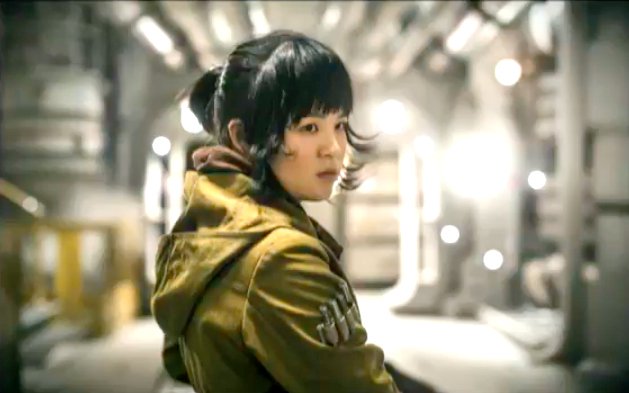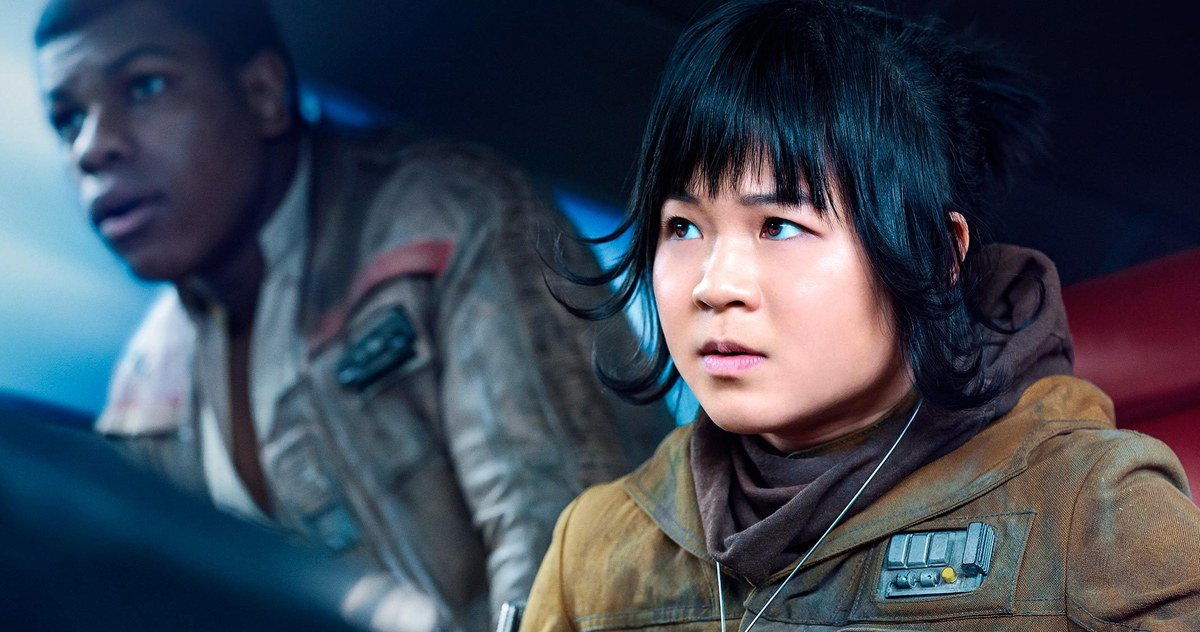I’ve seen Star Wars: The Last Jedi, and like the majority (save for a handful of fans, who I’ll have words about later on once spoiler fever has died down), I absolutely loved the film. The storyline and its more cerebral themes were amazing and refreshing–as SyFy Fangrrls/SyFyWire contributing editor Carly Lane wrote on Twitter, this is the most cerebral Star Wars film yet–and the introductions of new characters such as Rose Tico (Kelly Marie Tran) and DJ (Benecio Del Toro) were organic and fun. It’s as if these characters have been around since the beginning.
Rose is also one of the characters that reminded me how little women of color are shown in Star Wars and how I wish I, as a black woman, could have had the same kind of representational experience in this fictional galaxy.
Watching Rose

I was excited to see not Rose and her sister Paige, to see representation long overdue. It was gratifying to watch Rose challenge Finn on his planned desertion and to inspire hope in him and the rest of the Resistance. She’s a tremendous force in this film, and I think the film–and the franchise–is better for it.
I’m extremely happy that finally, after an entire two years of back-to-back whitewashing of Asian characters and stories, a big blockbuster film has put an Asian character at the center of its story. I’ve covered so many films that negate Asian characters or recast them as white actors, and there are even some projects I haven’t covered just because I couldn’t bring myself to write about yet another property that just didn’t get what it was doing. But seeing Rose was seeing what films can do when they are created by someone conscientious enough to tackle proper representation.
There was one thing that held me back a bit during my viewing of The Last Jedi—Star Wars has yet to give an African-American female character the same treatment as Rose. To be fair, Star Wars has yet to give a character who looks like me more than five seconds on screen.
Watching Rose kick the film into high gear reminded me of a coping mechanism I’d developed as a child on the chance I was watching a TV show that had no black women as a part of its cast. As a kid, I’d gravitate towards the character who was a minority like me and live vicariously through that character. The first time I remember doing this was as a 5-year-old watching Mighty Morphin’ Power Rangers. There was a black man as part of the cast, but no black women. But, there was Thuy Trang’s character Trini Kwan, the Yellow Power Ranger. Trini was my way into Power Rangers, and during recess, when my friends and I would pretend to be the Power Rangers, I would always make sure I got the Yellow Ranger. She may not have been my same race, but to me, she represented me and other girls of color who weren’t represented on the show. As a child, seeing Trini kick butt and be cool helped me formulate my personal voice and worldview. Through Trini, I felt like I could have a place on a show that apparently wasn’t designed for me.
I felt the same way with Rose. Through her, I felt happiness because women of color were finally getting their overdue shot at being heroes. Young girls, Asian girls especially, will be able to see themselves included in a fantastical place like the Star Wars universe. That kind of feeling is one that is unmatched–I felt it somewhat when The Force Awakens introduced Finn (John Boyega) as one of our new Star Wars heroes.
But the black woman is still left out. Despite my love for Rose, what I can’t ignore is a deep, personal longing to see black girls (and grown women like me) represented on screen in a hero they can be proud of. The longing doesn’t stop at just my own race, though; when will all women of color get equal representation in Star Wars? Now that Rose is here, will the Star Wars powers that be realize they owe the members of Star Wars‘ WOC fanbase the heroes they deserve?
Star Wars’ WOC track record

Star Wars having a rough time with representing women of color is nothing new. In fact, I wrote about it last year during the Rogue One hype. As I wrote then, women of color are largely absent from the films despite having a larger presence in the books. One character, Imperial Naval Officer Rae Sloane and Han Solo’s former wife, Sana Starros, have important roles in the Star Wars saga. But not only is it unclear if Sana will be portrayed in the upcoming Han Solo prequel Solo: A Star Wars Story, but Rae has yet to make a film appearance in any of the new Star Wars films.
Combine that with the fact that there is a highly sought-after actress that is a part of the films, but is currently stuck playing behind CG and motion-capture. Lupita Nyong’o was a big get for the franchise–The Force Awakens was one of her first acting roles after winning the Oscar for her role in 12 Years A Slave. But she has been tasked with portraying Maz Kanata, a character who is lively and fun, but is fully computer-generated. All we hear of Nyong’o is her voice.
Before Rose, the most prominent Asian female character in Star Wars was Janina Gavankar’s Iden Versio in the video game Star Wars: Battlefront II. But, like Rae and Sana, it’s unclear if Iden will ever show up in any film or TV Star Wars properties. Ditto for Shara Bey, Poe Dameron’s mother, who does appear in the comic book series Star Wars: Shattered Empire. Women of other racial and ethnic groups, such as Native American women, have no representation at all.
Adding insult to injury is how Star Wars has typically used women of color as WOC-coded sex aliens. As I wrote back in 2016:
Another strike against Lucasfilm and the Star Wars universe is how often black women and other women of color are often cast as Twi’leks, whose women are often enslaved as sex objects. To quote Wookipedia:
“Since female Twi’leks were regarded as graceful and beautiful beings, many of them were forced into a life of slavery at the hands of the galaxy’s wealthy and powerful.”
It’s more than a little disturbing that while women of color are all but absent in the Star Wars universe, they are readily cast as women who are sold into a sexual slavery.
It’s even more disturbing that Oola, the only sex slave coded as a black woman due to the actress, gets killed moments after we see her on screen in Return of the Jedi. There could have been a better outcome for her instead of just being used as disposable eye-candy.
To The Last Jedi co-writer/director Rian Johnson’s credit, he did make it a point to showcase more women of color, particularly African-American women, in scenes. One of the biggest cameos of the film is Chewing Gum‘s Michaela Coel as a Resistance tech. We see another black woman as a Resistance fighter pilot, and a South Asian woman is also featured as part of General Leia’s (Carrie Fisher) ragtag team. Black women and other women of color also feature heavily in the luxurious Canto Bight scenes.
But the scenes that do feature women of color, black women especially, only feature them either in the background or in non-speaking cameos. We never get to intimately know other women are who are Latina, Native American, African-American or South Asian, etc. Much like the lone black woman in Rogue One, we know women of color do exist in this far away galaxy, but we never know them outside of being set dressing.
That’s what makes Tran as Rose even more powerful. Johnson said he cast regardless of ethnicity for Rose, and that opportunity–unencumbered by preconceived notions of what a “Rose Tico” should look like–led Johnson to finding the perfect person for the part.
“We saw a lot of talented actresses of a very broad range–but honestly, it was more about finding Kelly,” said Johnson to The Los Angeles Times‘ Jen Yamato. “There was something about Kelly that had that kind of genuine oddball nature and a real sweetness to her. She has the most open heart of anyone I’ve ever met and I knew that this was going to shine through onscreen. I knew that I was going to be rooting for her in the movie.”
As Yamato wrote, Johnson’s decision to create Rose as a main character and casting inclusively “led to the biggest leap forward for Asian representation Hollywood has ever dared to make on such a large scale.”
Watching Rose on screen provided me with both pride at seeing a woman of color finally take the reins of a Star Wars film, but it also made me a bit wistful that we have yet to see other women of color get the same opportunity.
But where Rose has paved the way, surely others will follow, right?
First Rose, now others
Let’s go back to Solo. This movie is the closest on the horizon, and it’s also the Star Wars can finally break the color barrier. Even though it’s unclear who Emilia Clarke is playing (reportedly, it was a role actresses like Tessa Thompson, Zoe Kravitz, and Adria Arjona tried for as well), Thandie Newton is also rumored to be part of the cast. We have virtually no substantial casting news on this front, so we have to wait until we get closer to the film’s 2018 release date. But, if Newton is a big part of the Solo cast, then she could very well be part of a new wave of diverse Star Wars leading ladies.
Regardless, Star Wars should come to grips with their startling avoidance of women of color. Now that inroads are being made thanks to Rose, writers and directors should continue to make giving women of color a voice in Star Wars a priority. Not as sex slaves and not as CG characters but as the heroes. Hopefully, Rose is the first of many more like her.
Loved this article? Follow JUST ADD COLOR at @COLORwebmag and on Facebook!

